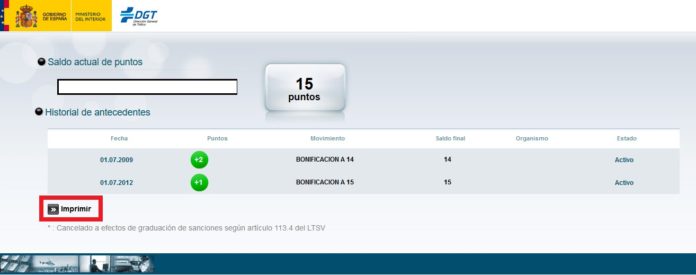The driving Penalty Points system in Spain acts in the opposite way to that of the United Kingdom. In the UK, if you commit a motoring offence, you gain points, whereas in Spain, you start with a balance that reduces if you commit certain offences.
First introduced in Spain in 2006, the operation of the points system has been relatively simple. When the system was introduced, all drivers were allocated 12 points, or 8 in the case of novice drivers. Three years later, if we had not lost any points, they gave us another 2 points and finally another three years later they gave us another one, with which the maximum points a driver could have being 15.
Checking your balance of points is simple, if you are able to access the DGT website or the miDGT app, for which a token such as a Digital Signature is required.

In the event of a driver not having any points, in other words, they have lost their allocation, they are not permitted to drive. Doing so is a criminal offence punishable by a fine between 1,500 and 6,000 euro, depending on factors such as whether the driver is a repeat offender, and can be accompanied by prison sentences between 3 and 6 months and community work between 30 and 90 days. That said, it is estimated that up to 100,000 people in Spain still drive under those conditions, some of whom may not be aware of their status, which is why it is important to check periodically.
Losing points is something that can happen to anyone. The system is not about treating drivers as criminals, whether or not they have licence points, but what is necessary is to carry out awareness and road safety work to reduce road accidents and increase safety behind the wheel.
Of course, not all offences result in the loss of points. But if you do lose them, there are ways in which you can recover your points.
Under normal circumstances, the process begins with a notification from the DGT, normally by letter, in which we are informed that we no longer have points on our licence, so we must stop driving until we follow the process for their recovery. It is possible that the notification never arrives, for a variety of reasons, which is why we must check ourselves also. This is where the problem begins, since up to seven out of ten drivers are not clear about the process for recovering points.
The recovery process is not complicated, but it cannot be said to be fast under any circumstances. There is the possibility of taking a road awareness and re-education course every two years. With this course we can recover 6 points, up to the maximum.
The cost varies in different Autonomous Communities. In Catalonia, for example, it´s around 225 euro, in the Basque Country 230 euro, the Canary Islands about 188 euro, but for most of Spain, the price is around 213 euro. The course itself lasts for 12 hours, normally distributed over two consecutive days of 6 hours each. The course is of course in Spanish, so those who don´t speak the language too well will find it difficult.
There is another way of recovering points, although this takes a lot longer, but is not dependant on language skills, just the passage of time. If you don’t commit another point-losing offence in two years, the DGT will return two points back to you. This process is then repeated until you reach 12.
In the event of you losing six points in one go, the recovery time is longer though.
There is bad news in the event of your points balance reaching zero, as the recovery then takes even longer, and you must take a longer and more complex course at the Provincial Traffic Headquarters. In this case, the course lasts 24 hours and is given over two weekends.
It has a cost between 350 and 450 euro, depending on the Community, and completion of the full course is mandatory, as is passing an exam at the end. It can be done the day after losing the points, but in no case will we recover them before six months, which will force us to spend half a year without driving; 12 months if we are repeat offenders.
By the way, the exam is not easy at all, the fees are 30 euro and it gives the right to three attempts, but after each failure you must take a new 4-hour course. The exam consists of 30 multiple choice questions, with a maximum of 3 errors permitted.





